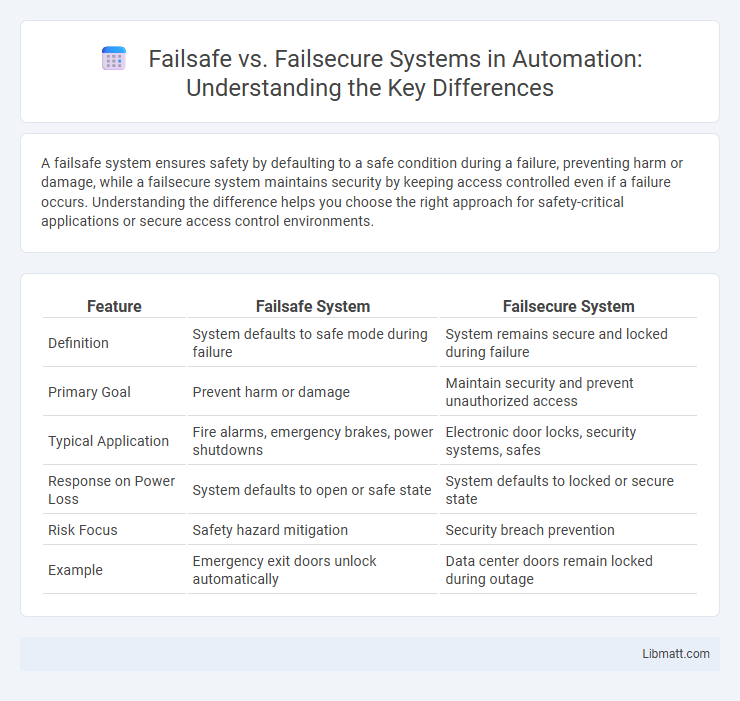A failsafe system ensures safety by defaulting to a safe condition during a failure, preventing harm or damage, while a failsecure system maintains security by keeping access controlled even if a failure occurs. Understanding the difference helps you choose the right approach for safety-critical applications or secure access control environments.
Table of Comparison
| Feature | Failsafe System | Failsecure System |
|---|---|---|
| Definition | System defaults to safe mode during failure | System remains secure and locked during failure |
| Primary Goal | Prevent harm or damage | Maintain security and prevent unauthorized access |
| Typical Application | Fire alarms, emergency brakes, power shutdowns | Electronic door locks, security systems, safes |
| Response on Power Loss | System defaults to open or safe state | System defaults to locked or secure state |
| Risk Focus | Safety hazard mitigation | Security breach prevention |
| Example | Emergency exit doors unlock automatically | Data center doors remain locked during outage |
Understanding Failsafe and Failsecure: Key Definitions
Failsafe systems are designed to default to a safe condition during a failure, preventing harm to people or equipment by shutting down or locking mechanisms. Failsecure systems, in contrast, maintain security during faults by keeping doors locked or systems operational to prevent unauthorized access. Understanding these key definitions helps you select the appropriate safety or security strategy based on your risk priorities.
Core Principles Behind Failsafe and Failsecure Systems
Failsafe systems are designed to default to a safe condition in the event of a failure, prioritizing safety and minimizing harm by shutting down or locking mechanisms to prevent accidents. Failsecure systems, on the other hand, maintain security by defaulting to a locked or secure state when a failure occurs, ensuring restricted access and protection against unauthorized entry. Both systems rely on robust control logic and reliable failover mechanisms to uphold their respective safety or security objectives under fault conditions.
How Failsafe Systems Work in Practice
Failsafe systems operate by defaulting to a safe condition during a failure or emergency, often by using mechanical or electrical means to ensure critical functions like unlocking doors or shutting down machinery. These systems prioritize preventing harm or further damage, activating safety mechanisms such as emergency power supplies or fail-open locks that maintain user safety. Your facility benefits from failsafe designs by minimizing risk and ensuring that safety protocols are reliably enforced, even when power or control signals are lost.
How Failsecure Systems Work in Practice
Failsecure systems maintain security by locking doors or assets during power failures or detected breaches, preventing unauthorized access. These systems rely on electromagnetic locks or robust mechanical components designed to keep critical areas secure until authorized personnel intervene. Your facility benefits from failsecure designs by ensuring sensitive areas remain protected, even when power is lost or alarms are triggered.
Failsafe vs Failsecure: Main Differences
Failsafe systems are designed to default to a safe condition during a failure, ensuring minimal harm or damage by shutting down or activating protective measures. Failsecure systems, in contrast, maintain security by locking or securing critical access points even when power or communication is lost, prioritizing protection over immediate safety. Understanding these main differences helps you choose the appropriate system based on whether safety or security is your primary concern.
Use Case Scenarios: When to Choose Failsafe
Failsafe systems are essential in environments where safety and prevention of harm are critical, such as in fire alarm systems, emergency lighting, or medical devices, where power loss should trigger a safe, default response. Your choice of failsafe mechanisms ensures automatic system shutdown or activation of safety protocols to protect users and equipment during failures. Selecting failsafe over failsecure depends on prioritizing life safety and minimizing risk during power or component failures in your specific application.
Use Case Scenarios: When to Choose Failsecure
Failsecure systems are ideal for high-security environments such as data centers, banks, and government facilities where maintaining locked conditions during power or system failures prevents unauthorized access. In these scenarios, ensuring asset protection outweighs the need for immediate egress, making failsecure the preferred choice to maintain security integrity. Emergency response plans in failsecure settings often incorporate alternative access methods like backup power or manual overrides to balance safety and security.
Industry Applications: Security, Safety, and Beyond
Failsafe systems are critical in industries like healthcare and manufacturing where safety is paramount, ensuring machinery or processes revert to a safe state upon failure to prevent harm or damage. Failsecure systems dominate in high-security environments such as data centers and financial institutions, maintaining locked or protected states during power outages or faults to safeguard assets and information. Your choice between failsafe and failsecure designs depends on whether preventing safety hazards or protecting security is the higher priority in your industry application.
Best Practices for Implementing Failsafe and Failsecure Solutions
Implementing failsafe and failsecure solutions requires a thorough risk assessment to determine which system aligns with your operational priorities and security needs. Best practices include integrating redundant power supplies for failsafe systems to ensure safe operation during failures and employing secure locking mechanisms in failsecure systems to prevent unauthorized access. Regular testing and maintenance are critical to verify system reliability and responsiveness in both failsafe and failsecure configurations.
Choosing the Right System for Your Needs: Key Considerations
Choosing between a failsafe and failsecure system depends primarily on your security priorities and risk tolerance. Failsafe systems prioritize safety by defaulting to an open state during power failures, ideal for environments where emergency exits are crucial. Failsecure systems maintain security by remaining locked during failures, suitable for high-security areas where unauthorized access must be prevented even during outages.
Failsafe vs Failsecure System Infographic

 libmatt.com
libmatt.com